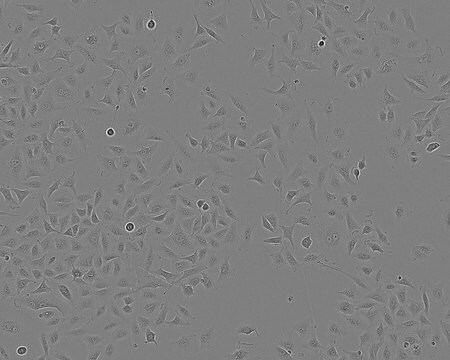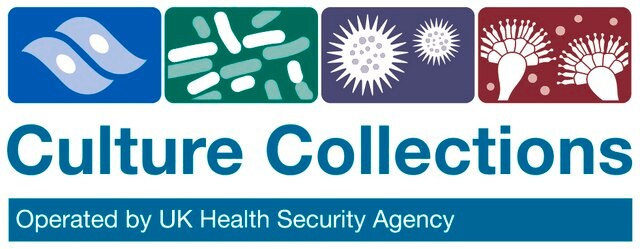RN46A
12061302, rat embryo d13 medullary raphe. Morphology: proliferating, fibroblast. Differentiating, neuronal.
Zaloguj sięWyświetlanie cen organizacyjnych i kontraktowych
About This Item
Kod UNSPSC:
41106514
pochodzenie biologiczne:
rat embryo (day 13 medullary raphe)
tryb wzrostu:
Adherent
kariotyp:
Not specified
morfologia:
Fibroblast morphology while proliferating and neuronal on differentiation
receptory:
Not specified
Polecane produkty
Nazwa produktu
RN46A, 12061302
pochodzenie biologiczne
rat embryo (day 13 medullary raphe)
tryb wzrostu
Adherent
kariotyp
Not specified
morfologia
Fibroblast morphology while proliferating and neuronal on differentiation
receptory
Not specified
Szukasz podobnych produktów? Odwiedź Przewodnik dotyczący porównywania produktów
Pochodzenie linii komórkowej
Embryonic rat medullary raphe, temperature-sensitive mutant of SV40 large T-antigen, immortalised, serotonergic, neuronal
Opis linii komórkowej
RN46A , an immortalized serotonergic neuronal cell line, was cloned by serial dilution following infection of dissociated embryonic day 13 rat medullary raphe cells with a retrovirus encoding the temperature-sensitive mutant of SV40 large T-antigen (T-ag), RN46A cells are capable of differentiating at 39 °C the non-permissive temperature. Under differentiation conditions, RN46A cells cease dividing, take on a neuronal morphology, and express enhanced levels of NSE and all three NF proteins. Differentiated RN46A cells express low-affinity nerve growth factor (NGF) receptor (p75NGFR) and are i mMunoreactive using an antibody that recognizes the carboxy-terminal 13 amino acids of all three trk proteins (pan-trk). Both i mMunoreactivities could be potentiated by treatment with brain-derived neurotrophic factor (BDNF), NGF, and adrenocorticotropic hormone, fragment 4-10 (ACTH4-10). Differentiated RN46A cells express low levels of tryptophan hydroxylase (TPH) i mMunoreactivity, which could be enhanced by treatment with ACTH4-10, BDNF, or NGF. Low levels of serotonin i mMunoreactivity are detected in differentiated RN46A cells, and this was potentiated by differentiating RN46A cells with BDNF for 8 d and 40 mM KCl for days 4-8. RN46A cells should prove useful to elucidate intracellular mechanisms that control neurofilament assembly and 5-HT expression in differentiating raphe neurons.
Profil DNA
Not specified
pożywka hodowlana
DMEM:F12 (1:1) (D8062) + L-Glutamine (G7513) + 10% FBS / FCS (F2442) + 0.25mg/ml Geneticin (G418). Alternatively CNS medium can be used (see Kawamoto & Barrett 1986). Differentiation can be induced as follows: cells growing at 33 °C are sub-cultured onto collagen/fibronectin matrix (100 μg/cm2 air-dried collagen I from rat tail followed by 1 μg/cm2 fibronectin). Sub-confluent cells (75%) are shifted to 39 °C. The culture medium is changed to DMEM:F12 (1:1) (D8062) + 1%(w/v) bovine serum albumin (BSA) + 1 μg/ml bovine transferrin + 5 μg/ml bovine insulin + 100 nM putrescine + 20 nM progesterone.
Rutyna subkultury
Split subconfluent cultures (70-80%) 1:2 to 1:5 using 0.25% trypsin/EDTA; 5% CO2; 33 °C. Suggested seeding density 2-4 x 10,000 cells/cm2. Doubling time 19hrs.
Inne uwagi
Additional freight & handling charges may be applicable for Asia-Pacific shipments. Please check with your local Customer Service representative for more information.
Ta strona może zawierać tekst przetłumaczony maszynowo.
Wybierz jedną z najnowszych wersji:
Certyfikaty analizy (CoA)
Lot/Batch Number
Przepraszamy, ale COA dla tego produktu nie jest aktualnie dostępny online.
Proszę o kontakt, jeśli potrzebna jest pomoc Obsługa Klienta
Masz już ten produkt?
Dokumenty związane z niedawno zakupionymi produktami zostały zamieszczone w Bibliotece dokumentów.
Nasz zespół naukowców ma doświadczenie we wszystkich obszarach badań, w tym w naukach przyrodniczych, materiałoznawstwie, syntezie chemicznej, chromatografii, analityce i wielu innych dziedzinach.
Skontaktuj się z zespołem ds. pomocy technicznej





